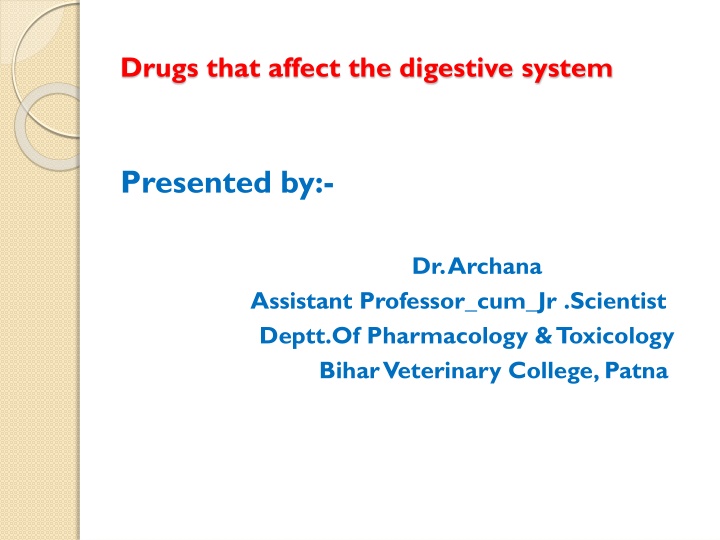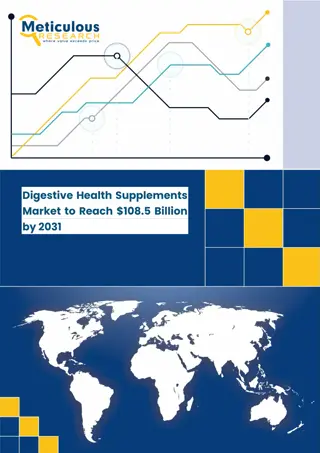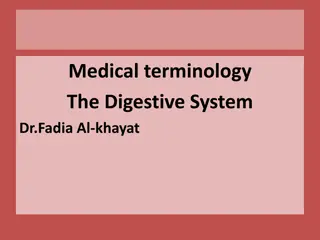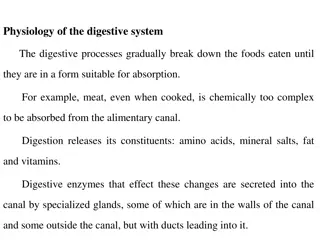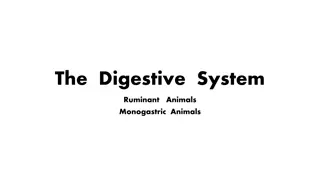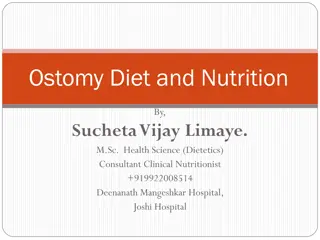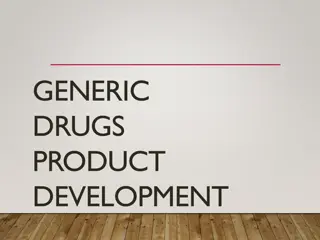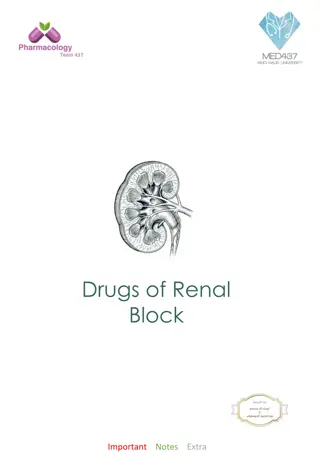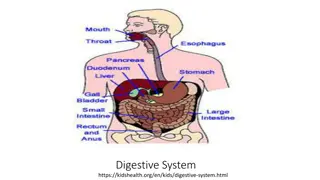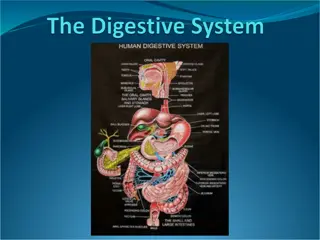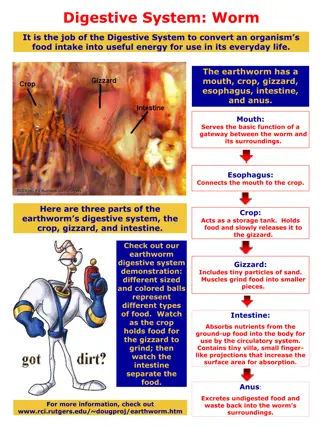Drugs Affecting the Digestive System and Their Functions
This presentation by Dr. Archana covers various drugs that impact the digestive system, such as antacids, intestinal astringents, antiemetics, and more. It explores the functions of these drugs and their roles in treating stomach-related issues like gastritis and peptic ulcers. The chapter discusses stomachics that enhance stomach function, antacids that neutralize excess stomach acid, and carminatives that aid in gas expulsion. Additionally, it delves into the importance of intestinal astringents in protecting intestinal tissues and the use of antizymotics to prevent excessive microbial activity in the gut.
Download Presentation

Please find below an Image/Link to download the presentation.
The content on the website is provided AS IS for your information and personal use only. It may not be sold, licensed, or shared on other websites without obtaining consent from the author.If you encounter any issues during the download, it is possible that the publisher has removed the file from their server.
You are allowed to download the files provided on this website for personal or commercial use, subject to the condition that they are used lawfully. All files are the property of their respective owners.
The content on the website is provided AS IS for your information and personal use only. It may not be sold, licensed, or shared on other websites without obtaining consent from the author.
E N D
Presentation Transcript
Drugs that affect the digestive system Presented by:- Dr.Archana Assistant Professor_cum_Jr .Scientist Deptt.Of Pharmacology & Toxicology Bihar Veterinary College, Patna
Content of chapter * Antacids * Intestinal Astringent * Antizymotic * Antiemetic * Cholagogue * Prokinetics * Rumen Pharmacology * Stomachics * Antiulcers * Carminative * Emetic * Laxative & Purgative * Choleretics * Antidiarrhoeals
STOMACHICS Stomachics are agents that increase the tone and function of stomach by increasing the gastric secretion and motility. Eg : Ginger, Chirata, Nuxvomica.
ANTACIDS Antacids are weak basic agents which neutralize excess acid in stomach. Eg :sodium bicarbonate, aluminium hydroxide Antacids are of two types :- Systemic antacid : these affect systemic acid-base balance. It produce acid rebound by releasing CO2. Eg : sodium bicarbonate. Nonsystemic antacids : these do not significantly affect acid base balance. Eg : Magnesium hydroxide, Aluminium hydroxide
Continue... The Nobel Prize in Physiology or Medicine 2005 "for their discovery of the bacterium Helicobacter pylori and its role in gastritis and peptic ulcer disease" Barry J. Marshall, Australia J. Robin Warren, Australia
INTESTINAL ASTRINGENT Intestinal astringent are the agents which makes protective barrier between the intestinal tissue and the irritant. These agents are used in the treatment of all type of diarrhoea. Eg : catechu, tannic acid, Aluminium hydroxide gel etc.
CARMINATIVES Carminatives are the agents which helps in the expulsion of gas from stomach, they have effect of mild irritation with vasodilation and relaxation of oesophageal sphincter and therefore assist in eructation process. Eg : Turpentine oil, ginger powder, anise etc.
ANTIZYMOTIC Antizymotics are the drugs which prevents or decereases excess microbial fermentation in rumen or intestine, used in bloat, tympanitic colic in horse or cattle. Eg Turpentine oil, linseed oil , Formalin etc.
EMETICS EMETICS : These are the agents which cause vomition in animals, which are capable of vomition. (horse, cattle & rats are unable to vomit effectively. Emetics are of two types :- Reflex emetics/ Irritant emetics : These agents cause vomition by irritating the epithelium of pharynx, oesophagus, stomach & duodenum and reflexly stimulate the emetic centre. Eg : sodium chloride, sodium carbonate, Hydrogen peroxide etc. Central emetics :These agent cause vomition by stimulating the medullary emetic centre directly or through CTZ Eg - Apomorphine hydrochloride : 3-5mg per k.g orally in dog. Xylazine 0.3-0.5mg per k.g IV or IM.
ANTIEMETICS Antiemetics are the agents which suppress emesis or abolish the sensation of vomition. Commonly used in cats and dogs. antiemetics are of two types :- Local acting : these agents coats, protects, lubricates and sooth the gastric mucosa. Eg: Dextrose, honey, Cooled-chilled milk. Central acting: These agents acts by blocking the dopaminergic receptor in the CTZ or by blocking the H1 receptor. Eg : Cyclizine, Diphenphydramine Metoclopramide, Phenothiazine,Droperidol
LAXATIVES & PURGATIVES : These drugs are commonly used to commonly accelerate the movement of bowel through the GIT. * purgatives tend to produce a more fluid evacuation. * Laxative in high dose may cause purgation. Exception is liquid paraffin which even in higher dose can not produce purgation. * Laxatives promote soft formed stool. * Laxative causes similar action but the effect is milder. * Small doses of purgatives may act as laxative.
CLASSIFICATIONS OF PURGATIVES 1. Lubricant laxatives (Emollient laxative,or faecal softeners) e.g., Liquid paraffin. 2. Bulk Purgatives: (a) Simple bulk purgatives :- carboxymethyl cellulose, wheat bran and isapgol husk (b) Saline bulk purgatives :- Sodium sulfate, Magnesium oxide, Magnesium Sulfate 3. Irritant purgatives: (a) Direct irritant purgatives :- Mercury compounds, Phenolphthalein and Vegetable oils. (b) Indirect irritant purgatives :- Aloes, Senna, Cascara, Anthraquinone (c) Drastic irritant purgatives :- Jalap, podophyllum, corotonil, barium chloride and colocynth. 4. Neuromuscular purgatives: parasympathomimetic drugs Pilocarpine, Arecholine, Physostigmine.
CHOLAGOGUE Substances that cause contraction of the gall bladder and increase the bile flow into the duodenum are called cholagogues. E.g- Arecholine, Oxytocin, Calomel etc.
CHOLERETICS: Substances that increase secretion of bile by the hepatocytes are known as Choleretics. E.g. - Natural bile salts like Glycocholate Taurocholate & Liver extract.
PROKINETICS Prokinetics are the drugs that promote downward movement of ingesta through the GIT, by inducing GI motility. * These drugs are used in gastric stasis & Reflux oesophagitis. E.g. Metoclopramide, domperidone, Neostigmine etc.
ANTIDIARRHOEALS These drugs are used to control diarrhoea, specially acute diarrhoea. Antidiarrhoeals are of two types :- GI mucosa protectactants Kaolin-Pectin, Activated charcoal & Bismuth subsalicylate GI motility inhibitors * Anticholinergic Propantheline, Aminopentamide *Opiates Diphenoxylate Diarrhoea due to microbes can be treated by antimicrobial drugs like Tetracyclines, Sulfonamides etc.
Rumen Pharmacology * Chloramphenicol,Trimethoprim, Cardiac glycosides etc are inactivated in anaerobic rumino-reticulum. * Ruminal metabolism increases or decreases the toxicity of toxicant. Eg- liberation of cyanide from cyanogenic glycosides, Parathion to aminoparathion * Large volume of rumino-reticular contents diutes or inactivates the drugs and reduce their absorption. * Rumino-reticular pH also significantly affects drug absorption Eg- weak bases remain ionised and weak acids remain unionized * on ruminal microflora drug exerts beneficial (antibiotic in bloat) and harmful effects (oral administration of broad spectrum antibiotics disrupts the microflora).
